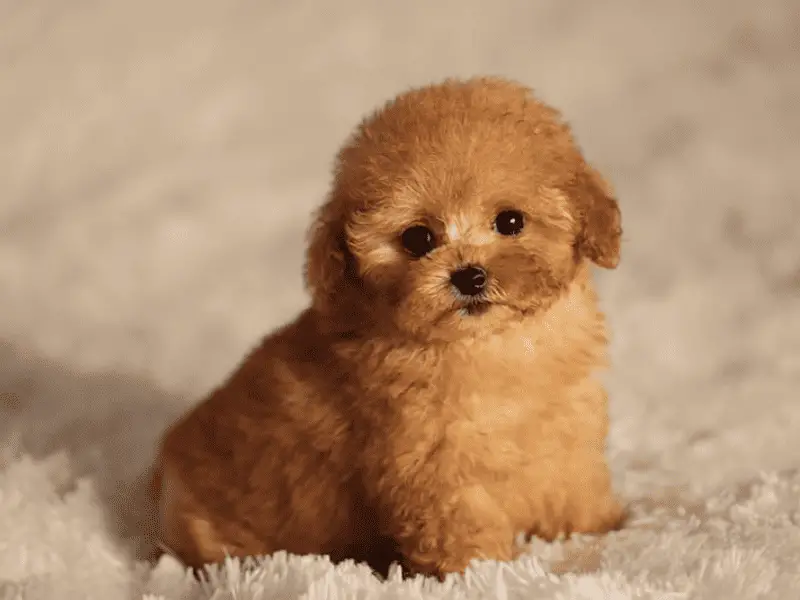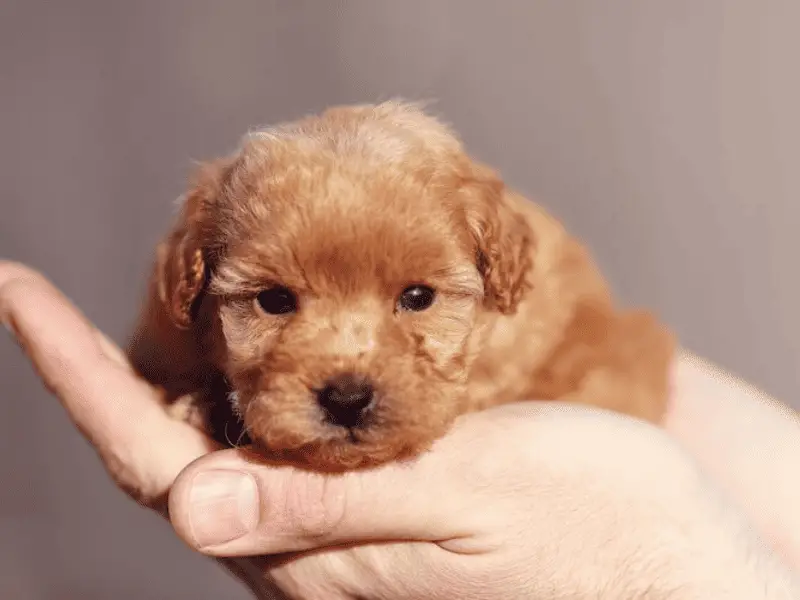Small dog breeds have been growing in popularity over the years. From cute Chihuahuas to adorable Pomeranians, these tiny pups are often seen as fashion accessories or lap dogs.

However, with the rise of teacup poodles, many dog lovers are left wondering: is there a breed smaller than this beloved breed? When it comes to small dogs, size does matter.
Smaller breeds are often easier to care for and require less exercise and space than larger breeds. This makes them ideal for apartment living and those who don’t have much outdoor space.
Plus, their pint-sized cuteness makes them hard to resist. But as with any trend, there’s always room for debate.
Some argue that breeding dogs for extreme sizes can lead to health problems and unethical practices. Others argue that owning a teacup pup is a personal choice that should be respected.
So where does this leave us when it comes to finding the smallest dog breed? Let’s explore some possibilities.
Teacup Poodle: A Petite and Elegant Dog
The teacup poodle is an elegant and petite breed that has been popular among dog enthusiasts for many years. This breed is a miniature version of the standard poodle, and it is known for its tiny size, intelligence, and charming personality.
Teacup poodles are highly sought after for their adorable looks and cuddly nature, making them an ideal pet for those seeking a small lap dog to keep them company. One of the most notable characteristics of the teacup poodle is its small size.
These dogs can weigh as little as two pounds when fully grown, with a height of just six to eight inches at the shoulder. Despite their tiny stature, they have a big personality that will win your heart in no time.
They are intelligent dogs that are quick to learn new tricks and commands, making them an easy breed to train. They also have a playful nature that lends itself well to interactive playtime with their owners.
The Pros and Cons of Owning a Teacup Poodle
As with any pet, there are pros and cons to owning a teacup poodle. On the plus side, these dogs are incredibly cute and make great companions for apartment dwellers or people who don’t have much space in their home or yard.
They are also hypoallergenic which makes them great pets for people with allergies. However, owning a teacup poodle also comes with some challenges.
Due to their small size they can be more vulnerable to health issues such as hypoglycemia or injuries from accidents around the house. They require careful handling from owners who need to ensure that they do not get injured while jumping off furniture or playing too rough with larger dogs.
Overall, teacup poodles make excellent pets for those who appreciate small, cute, and intelligent dogs. While they do come with some challenges, these can easily be overcome by responsible ownership and providing them with the love, attention and care that they require.
Smaller Dog Breeds
Comparing Small Dog Breeds: Chihuahuas, Yorkshire Terriers, and Pomeranians
If you’re looking for a small dog breed that’s smaller than a teacup poodle, you might consider one of the more popular small breeds. Chihuahuas are one of the smallest dog breeds in the world, with a maximum weight of 6 pounds. They are known for their big ears and feisty personalities.

Yorkshire Terriers, or “Yorkies,” are another small breed that typically weighs between 4-7 pounds. They have silky hair and can be very playful and affectionate.
Pomeranians are also a popular choice for small dog lovers, with an average weight of 3-7 pounds. But are these breeds actually smaller than teacup poodles?
It’s hard to say definitively because there is no standard definition for what qualifies as a “teacup” poodle. However, most teacup poodles weigh between 2-5 pounds, so it’s possible that some Chihuahuas or Yorkshire terriers could be larger than some teacup poodles.
The Debate on Teacup Dogs: Are They Safe?
One thing to keep in mind when considering smaller dog breeds is the potential health risks associated with breeding dogs to be extremely small. Teacup dogs in particular, have gained notoriety because they often suffer from various health problems as a result of their size.
For example, teacup dogs may be more prone to hypoglycemia (low blood sugar), which can cause seizures or even death if left untreated. They may also have issues with their teeth and be more susceptible to broken bones due to their delicate bone structure.
Before deciding on any small breed of dog, it’s important to do your research and make sure they are a good fit for your lifestyle. And if you do decide on a teacup dog, make sure to get it from a reputable breeder who prioritizes the health and well-being of their dogs over profit.
Rarely Known Small Dog Breeds
While teacup poodles and other popular small dog breeds are well-known, there are many smaller breeds that often fly under the radar. Two such breeds are the Russian Toy Terrier and the Biewer Terrier.

Russian Toy Terrier
The Russian Toy Terrier is a tiny breed with a big personality. Standing at only 8-10 inches tall and weighing between 3-6 pounds, these little dogs were originally bred in Russia as companions for aristocrats.
They have delicate features and come in two varieties: long-haired and short-haired. Despite their small size, Russian Toy Terriers are known for being alert, curious, and active.
They love to play and make excellent lap dogs. However, they do require a lot of attention from their owners and can become anxious if left alone for too long.
Biewer Terrier
The Biewer Terrier is a rare breed that originated in Germany in the 1980s. They are small dogs with silky coats that come in white with black or blue markings. Standing at only 7-11 inches tall and weighing between 4-8 pounds, they are one of the smallest terrier breeds.
Biewer Terriers have a friendly, affectionate nature but can be stubborn at times. They’re intelligent dogs that enjoy learning new tricks but may need some patience when it comes to housebreaking.
With proper training and socialization, they make great family pets. Overall, while not as well-known as teacup poodles or other popular small dog breeds, both the Russian Toy Terrier and Biewer Terrier have unique qualities that make them wonderful pets for those seeking a tiny companion.
The Debate on Teacup Dogs
When Small Gets Too Small: Ethical Concerns Surrounding Breeding for Extremely Small Sizes
Teacup dogs may be cute and popular, but there are ethical concerns surrounding the breeding of dogs to be extremely small. These dogs are often born with health issues that can result in a shorter lifespan and require expensive veterinary care throughout their lives.
Breeders often breed from a small gene pool in order to achieve the desirable tiny size, which can lead to genetic defects and health problems. In addition, some breeders will purposely stunt the growth of teacup dogs by underfeeding them or using other harmful methods.
This can result in physical deformities and chronic health problems such as hypoglycemia, respiratory issues, and seizures. It is important for potential owners to consider these ethical concerns before purchasing a teacup dog and only to support responsible breeders who prioritize the health and well-being of their animals.
For the Love of Teacups: Arguments For and Against Owning Teacup Dogs
There are passionate arguments both for and against owning teacup dogs. Supporters argue that these tiny pups make great pets for those who prefer smaller animals or live in smaller living spaces. They are also convenient for traveling due to their compact size.
Additionally, advocates claim that responsible breeding practices can minimize potential health problems. However, detractors argue that owning teacup dogs perpetuates harmful breeding practices that prioritize appearance over animal welfare.
Furthermore, some critics say that teacups require constant attention due to their vulnerability to various health issues such as low blood sugar levels, dental problems, tracheal collapse, or vision deficiencies because of their delicate frames.
Ultimately, it is up to each individual owner to carefully weigh the pros and cons before bringing a teacup dog into their lives -and if they do, to ensure that they are only supporting responsible and ethical breeders.
Conclusion
After exploring various small dog breeds, it seems that no breed is consistently smaller than the teacup poodle. Although some breeds, such as the Chihuahua and Yorkshire Terrier, may occasionally be smaller than teacup poodles, there are also larger individuals within those breeds.

It’s important to note that individual dogs can vary greatly in size and weight, even within a breed. While teacup dogs may seem like a cute and convenient option for those who live in small apartments or have limited space, it’s important to consider the potential health issues associated with breeding for extremely small sizes.
These dogs are susceptible to a variety of health problems, including hypoglycemia, dental issues, respiratory problems, and more. Additionally, their small size makes them more fragile and vulnerable to injury.
While there may not be a dog breed consistently smaller than the teacup poodle, it’s essential to prioritize responsible breeding practices and prioritize the health and well-being of our furry companions. Small dogs can still make great pets without sacrificing their physical health for our entertainment.



